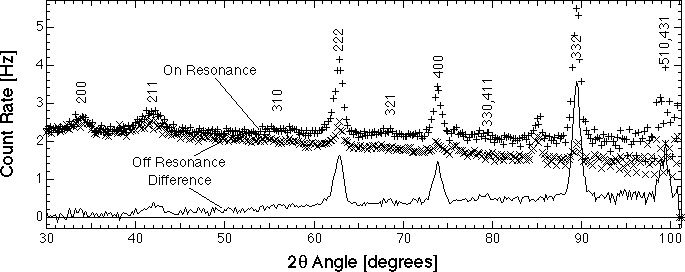
Kinematical Diffraction with a
57Fe Mössbauer Powder Diffractometer having an Area DetectorB. Fultz and U. Kriplani
California Institute of Technology, mail 137-78, Pasadena, CA 91125 USA
In the kinematical (single scattering) limit, the diffraction pattern is proportional to the Fourier transform of the autocorrelation function of the scattering factor distribution. This relationship has proved useful for solving crystal structures by diffraction methods. Because of low flux, however, few experiments have been attempted with Mössbauer powder diffractometry in the kinematical limit.
We have incorporated a Siemens/Nicolet area detector into our Mössbauer powder diffractometer. This detector has low noise (~10 Hz), has a quantum efficiency of about 70 % for 14 keV photons, and intercepts a solid angle of about 1 sR. The detector is mounted on a goniometer from an x-ray powder diffractometer, and is moved around the 2q axis in 1 degree increments to provide signal averaging.
A diffraction pattern from a textured 57Fe foil is shown in Fig. 1. The "On-Resonance" diffraction pattern was obtained with the Doppler drive tuned to the first peak in the 57Fe magnetic sextet (the —1/2 to —3/2 transition). The "Off-Resonance" pattern was measured for a velocity range around 20 mm/s, and shows a diffraction pattern from Rayleigh scattering. The "Difference" of these two diffraction patterns is approximately the intensity of the Mössbauer diffraction (neglecting interference effects). The incoherent background in the bottom pattern shows the expected angular dependence. Mössbauer energy spectra were then acquired from different parts of the diffraction pattern. We found no lineshape modification by dynamical speedup. It appears that the Mössbauer diffraction pattern in Fig. 1 is in the kinematical limit. Effects of polarization and interference are being investigated.

FIGURE 1 Diffraction patterns from bcc 57Fe measured in 13 h each with 50 mCi source.